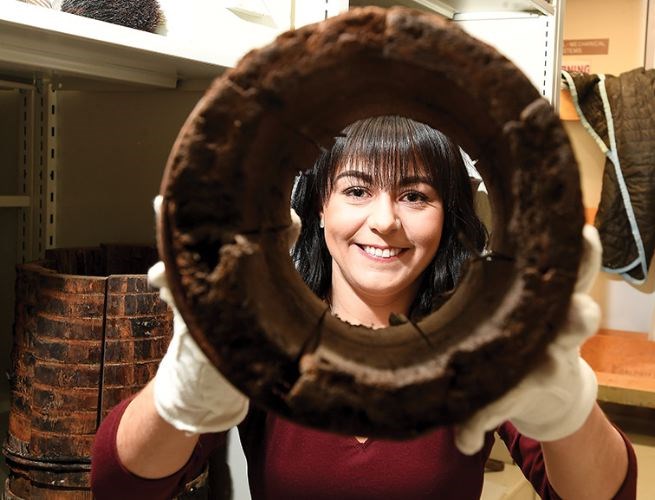The Exploration Place has always been Prince George's pipeline to the past, but now the City of Prince George has passed them some historic pipeline.
One of the reasons the new housing development beside city hall ran into months of delays was the old infrastructure that got uncovered during the dig. One of the most surprising discoveries was the presence of wooden water pipes, also known as staves, that once serviced the homes and businesses of George Street back at the beginning of the 20th century. Some of that piping was in remarkably good condition today.
It was only an arm's length of it, but city staff felt The Exploration Place should have a section of this piping as an artifact telling a little story of our municipal infrastructure history.
The pipe is a circular column composed of wood sliced at angles and fitted together with tongue-in-groove joints. Imagine a long, straight wine barrel wrapped in thick wire. The joints were slightly loose to the touch.
"The water would expand the wood and tighten the joints," said Exploration Place curator Alyssa Tobin-Leier.
The general properties and usage of these wooden utility pipes were already known at The Exploration Place. Someone had donated a smaller section that had been used to connect a house to the city's larger wooden watermains. The homeowner's piece was eight inches in diameter while the piece donated by the city was 10 inches.
"Someone donated a sample to us when they found it on their property on Johnson Street," Robin-Leier said. "It was about one and a half metres (approximately five feet) below the ground's surface."
The two segments are now stored in the same artifact locker inside the museum's repository.
The two pieces seem to be constructed of fir and show little signs of rot. What decay exists could have developed post-use. It was not, therefore, a shortsighted idea to use wood as buried water vessels. Tobin-Leier even found a historical photo from this region showing outflow pipes several feet in diameter in what might be a dam construction project.
"The stave we just got from the city probably dates back to the 1910s," said Tobin-Leier.
"That is when there was a water tower constructed on Connaught Hill to gravity-feed water to the town site down below, and these pipes would likely have been connected to that. They tore the water tower down in 1958, so that's when the stave system would have gone into disuse. When the city crews were digging for the new housing complex, they found clay and metal pipes as well, all of them old, and there was no reliable map of the underground infrastructure back then, so they were coming across this system basically by accident as they worked."
In the Jan. 30, 1915 edition of the Prince George Post newspaper, it was written that a Col. Thompson assessed the sewage, water and lighting systems of the upstart town. Thompson's report stipulated that there was 700 feet of 10-inch pipe on Quebec Street.
A total of 3,812 feet of eight-inch pipe ran along Third Avenue between Brunswick and George Streets plus along George Street from First Avenue to the standpipe on Connaught Hill.
A total of 1,980 feet of six-inch pipe ran along segments of Patricia Boulevard; Quebec, Brunswick and Ontario Streets; and Third, Fourth and Fifth Avenues.
It was in aid of commercial and residential water supply, and also firefighting. The cost of the pipes, valves, crosses, plugs, nine hydrants and an engine, connections, tanks and other associated stuff amounted to $47,800. That amount was calculated on the estimated price of steel pipe, plus its shipping, plus installation at seven feet of depth, based on case studies in Calgary and Edmonton.
There was a necessity to use a system of three-inch pipes to service residents but that, said the report, would offer "practically no fire protection" and should be "of a purely temporary nature."
The report indicated factors like proximity to railroad, runoff from nearby hills, proximity to sawmills, the presence of a former river channel, and the array of existing wells as part of planning that should be considered for future expansion of the water utility system.
"For a long time to come the standpipe on Connaught Hill will serve for Prince George, South Fort George and all intervening country," said Thompson's report, as published by The Post. "If a large population should settle in Fort George near or west of Central Avenue, in order to balance circulation, a second standpipe, holding water at the same elevation as the one on Connaught Hill will have to be erected, probably near the intersection of Winchester and Seventh Avenue."
As another option, the one favoured by Thompson, the municipality was also advised to secure freshwater sources near the river "at points close to the railroad."



